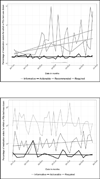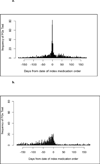Characterizing Pharmacogenomic-Guided Medication Use With a Clinical Data Repository
- PMID: 28073152
- PMCID: PMC5503815
- DOI: 10.1002/cpt.611
Characterizing Pharmacogenomic-Guided Medication Use With a Clinical Data Repository
Abstract
The extent to which pharmacogenomic-guided medication use has been adopted in various health systems is unclear. To assess the uptake of pharmacogenomic-guided medication use, we determined its frequency across our health system, which does not have a structured testing program. Using a multisite clinical data repository, we identified adult patients' first prescribed medications between January 2011 and December 2013 and investigated the frequency of germline and somatic pharmacogenomic testing, by the Pharmacogenomics Knowledgebase level of the US Food and Drug Administration label information. There were 268,262 medication orders for drugs with germline pharmacogenomic testing information in their drug labels. Pharmacogenomic testing was detected for 1.5% (129/8,718) of medication orders with recommended or required testing. Of the 3,817 medication orders associated with somatic pharmacogenomic testing information in their drug labels, 20% (372/1,819) of required tests were detected. The low rates of detectable pharmacogenomic testing suggest that structured testing programs are required to achieve the success of precision medicine.
© 2017 American Society for Clinical Pharmacology and Therapeutics.
Conflict of interest statement
Patrick C. Mathias – I have nothing to disclose.
Nathaniel Hendrix – I have nothing to disclose.
Wei-Jhih Wang – I have nothing to disclose.
Katelyn Keyloun– I have nothing to disclose.
Maher Khelifi– I have nothing to disclose.
Peter Tarczy-Hornoch– I have nothing to disclose.
Beth Devine – I have nothing to disclose.
Figures


Similar articles
-
The Ubiquitous Pharmacogenomics consortium: making effective treatment optimization accessible to every European citizen.Pharmacogenomics. 2017 Jul;18(11):1041-1045. doi: 10.2217/pgs-2017-0093. Epub 2017 Jul 7. Pharmacogenomics. 2017. PMID: 28685652 No abstract available.
-
The challenges of implementing pharmacogenomic testing in the clinic.Expert Rev Pharmacoecon Outcomes Res. 2017 Dec;17(6):567-577. doi: 10.1080/14737167.2017.1385395. Epub 2017 Oct 3. Expert Rev Pharmacoecon Outcomes Res. 2017. PMID: 28949250 Review.
-
Clinical Trial Designs to Support Clinical Utility of Pharmacogenomic Testing.Pharmacotherapy. 2017 Sep;37(9):1000-1004. doi: 10.1002/phar.1971. Epub 2017 Jul 26. Pharmacotherapy. 2017. PMID: 28605049 Review.
-
Veterans Affairs Pharmacogenomic Testing for Veterans (PHASER) clinical program.Pharmacogenomics. 2021 Feb;22(3):137-144. doi: 10.2217/pgs-2020-0173. Epub 2021 Jan 6. Pharmacogenomics. 2021. PMID: 33403869
-
Rapid point of care testing: the next frontier in pharmacogenomics.Pharmacogenomics. 2024;25(7):289-291. doi: 10.1080/14622416.2024.2366691. Epub 2024 Jul 23. Pharmacogenomics. 2024. PMID: 39041736 Free PMC article. No abstract available.
Cited by
-
Patients dispensed medications with actionable pharmacogenomic biomarkers: rates and characteristics.Genet Med. 2021 Apr;23(4):782-786. doi: 10.1038/s41436-020-01044-2. Epub 2021 Jan 8. Genet Med. 2021. PMID: 33420348 Free PMC article.
-
Informing Implementation Strategies for Pharmacogenomics in Cancer: Development of Survey Tools for Healthcare Professionals and Consumers.Clin Transl Sci. 2025 Mar;18(3):e70144. doi: 10.1111/cts.70144. Clin Transl Sci. 2025. PMID: 40103279 Free PMC article.
-
Analyzing Precision Medicine Utilization with Real-World Data: A Scoping Review.J Pers Med. 2022 Apr 1;12(4):557. doi: 10.3390/jpm12040557. J Pers Med. 2022. PMID: 35455673 Free PMC article.
-
Real-World Utilization of Medications With Pharmacogenetic Recommendations in Older Adults: A Scoping Review.Clin Transl Sci. 2025 Feb;18(2):e70126. doi: 10.1111/cts.70126. Clin Transl Sci. 2025. PMID: 39967300 Free PMC article.
-
Pharmacogenomic Testing: Clinical Evidence and Implementation Challenges.J Pers Med. 2019 Aug 7;9(3):40. doi: 10.3390/jpm9030040. J Pers Med. 2019. PMID: 31394823 Free PMC article. Review.
References
-
- Center for Drug Evaluation and Research Table of Pharmacogenomic Biomarkers in Drug Labeling. 2014
-
- Frueh F, et al. Pharmacogenomic Biomarker Information in Drug Labels Approved by the United States Food and Drug Administration: Prevalence of Related Drug Use. Pharmacotherapy: The Journal of Human Pharmacology and Drug Therapy. 2008;28:992–998. - PubMed
-
- Stanek, et al. Adoption of Pharmacogenomic Testing by US Physicians: Results of a Nationwide Survey. Clinical Pharmacology & Therapeutics. 2012;91:450–458. - PubMed
Publication types
MeSH terms
Grants and funding
LinkOut - more resources
Full Text Sources
Other Literature Sources
Molecular Biology Databases

